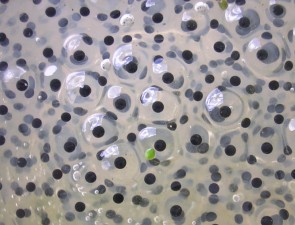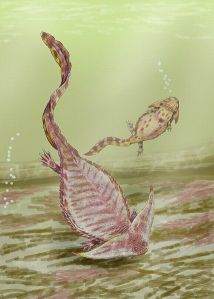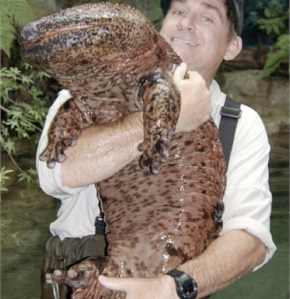by Chris Angell
This week, the discovery of a new Triassic amphibian species has made headlines across the ‘net. Touted as “a Triassic terror” and “super salamander,” Metoposaurus algarvensis was a six-foot-long aquatic beast that lived in Portugal alongside some of the early dinosaurs. It probably ate mostly fish and may have lived like a modern crocodile. Despite the hype surrounding Metoposaurus, this “super salamander” is not the biggest (or the most interesting) extinct amphibian we know of!


Before we go any further, let’s be clear about what animals we’re talking about. Amphibians (from the Greek for “double life,” due to their life cycle that spans both land and water) are vertebrates with four legs and moist skin, which return to water to breed. Unlike reptiles and birds, whose eggs are covered by a protective shell, amphibian eggs are jellylike and usually have to stay wet to survive. Frogs and salamanders make up most of today’s amphibians, although there is a third, lesser-known group called the caecilians.
Metoposaurus belong to a group of early amphibians called Temnospondyls, whose relationship to modern frogs and salamanders is unclear. They may have been the ancestors of modern amphibians (or it might have been another group called Lepospondyls). But what is clear is that 250 million years ago, Temnospondyls were fearsome creatures!
A six-foot long salamander might sound huge, but Metoposaurus was far from the biggest amphibian during their heyday. The longest amphibian to ever walk the Earth (or rather, swim the rivers and ponds) was the Brazilian Prionosuchus, a 30-footer, which looks strikingly similar to today’s gharials. Coming in second is the 16-foot-long, Australian Koolasuchus, with its flat, rounded head. “Suchus,” in both of their names, comes from the Greek word for crocodile, referencing their size and lifestyle.


Probably the most striking extinct amphibian is Diplocaulus, from Morocco: a three-foot-long Lepospondyl with a boomerang shaped head. Nobody knows for sure why its skull was shaped this way. Maybe it worked like an airplane wing, generating some lift as Diplocaulus swam through the water. Or perhaps it was defensive: you would have to have a pretty big mouth to swallow something with a head like this!
There were some pretty big and crazy amphibians in the past, but don’t worry! We’ve still got a few gigantic salamanders of our own. The appropriately named “Giant Salamanders” are a family that can be found in Asia and the United States. The American species, the hellbender, can reach up to two feet in length and can be found from New York to Mississippi and as far west as southern Indiana. But the Asian giant salamanders put ours to shame! The Chinese giant salamander, the largest living salamander species, can be up to six feet long! Unfortunately these salamanders are highly endangered due to habitat destruction and overhunting for use in Chinese medicine.


